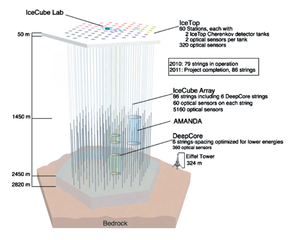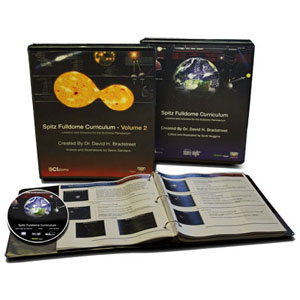Earlier this month, another “multi-messenger” announcement was made of the discovery of a new astronomical outburst by different instruments that study different parts of the universe. The first major multi-messenger astronomy discovery was announced last year after the collision of two neutron stars was observed in the nearby galaxy NGC 4993. The neutron star collision was observed first with the LIGO and Virgo gravitational wave detectors, coincident with a gamma ray burst detected by the Fermi space telescope, pinpointed with an optical telescope in South America, and followed up with different kinds of detectors.

from IceCube Science Team
This new announcement is based on the detection of a very unusual neutrino or “ghost particle” at the IceCube Neutrino Observatory at the South Pole. This event is worth pointing out in SciDome because we have a horizon panorama that matches the horizon at the South Pole, and one or two other points that may help students understand how the sky works and what neutrinos are.
Neutrinos have been observed with detectors in both the northern and southern hemispheres of Earth, and they are created as a byproduct of various nuclear reactions. Neutrinos hardly interact with normal matter at all, and they tend to radiate outwards from their point of creation at the speed of light.
Neutrinos at rest were assumed to be massless until evidence to the otherwise shown by Art McDonald and Raymond Davis, Jr., led to them being awarded the Nobel Prize in Physics in 2015.
The interaction of neutrinos with normal matter is so weak that most neutrinos that encounter the Earth fly straight through it without hitting anything. In February 1987 when a nearby supernova popped off in the Large Magellanic Cloud, 25 neutrinos were detected at neutrino observatories in the northern hemisphere, where the Large Magellanic Cloud never rises above the horizon.
The new neutrino detection from IceCube at the South Pole was detailed enough to provide a vector back to its point of origin, somewhere within a 1.3-degree-wide circle on the sky.

The circle enclosed a radio source discovered in 1983, a galaxy 3.7 billion light years away with an active supermassive black hole at its core. This is one of the quasars like Dr. Bradstreet uses in his “Quasars Fulldome” show from the Fulldome Curriculum Vol. 3. Because this quasar’s jet is pointed at us, it is called a “blazar”; this term originated because the first of its type happened to be named “BL Lacertae”, and because blazars can appear brighter than normal quasars and their brightness can vary more quickly than normal quasars.
Like before, this neutrino detected from the South Pole had flown through the Earth to get to the detector. The blazar TXS 0506+056 is located at about 5 hours right ascension and +5° north of the celestial equator. Only objects south of the celestial equator are above the horizon as seen from the South Pole.
TXS 0506+056 is conveniently located in the Shield of Orion, part of the most easily recognized equatorial constellation on the sky. The blazar is labeled “MG 0509 +0541” in SciDome and is one of the quasars in Dr. Bradstreet’s “Galactocentric Distributions” minilesson.
In the part of the Fulldome Curriculum “Seasons” class that visits the South Pole, the audience may have a hard time recognizing Orion because it is upside down and its northern half, including TXS 0506+056 is below the horizon. The horizon needs to be switched off and then tilted up to bring the rest of the constellation into view to simulate a “neutrino filter”.
The prefix TXS stands for ‘Texas’, where UT-Austin astronomers set up a radio telescope array outside of Marfa for several years in the 1980s – now removed. MG stands for ‘MIT-Green Bank Observatory’.
The mass of neutrinos and other particles is calculated in electron volts, but because they are so small, only particles that have a large amount of kinetic energy are comparable to things that we can comprehend. 1 trillion electron volts (1 TeV using the prefix tera-) is comparable to the kinetic energy of a mosquito in flight. The most powerful cosmic ray ever detected had a mass of 300 quintillion electron volts, comparable to a pitched baseball.
The single neutrino detected by IceCube from TXS 0506+056 had a mass of 290 TeV. After crossing 3.7 billion light years in space, this is by far the most distant neutrino emission ever detected: the only other objects in the sky that have produced detected neutrinos have been the Sun (8 light-minutes away) and Supernova 1987A (168,000 light-years.)
(In 2012, the IceCube Collaboration detected three other high-energy neutrinos, which they named Bert, Ernie and Big Bird, but where Bert and Ernie came from is not known, and Big Bird was probably generated by the blazar PKS B1424-418 with a certainty of 95%. That’s only two sigma, which does not hold water with particle physicists who have much stricter statistical significance limits. TXS 0506+56 was much more narrowly confined.)
Because matter and energy are relative, an electron volt is equivalent to the energy exchanged by the charge of a single electron moving across an electric potential difference of one volt. The only way a neutrino can be detected is on the rare occasion when it enters a neutrino detector (like a large underground tank of heavy water or tetrachloroethylene or linear alkylbenzene or another chemical) and collides with an atomic nucleus or an electron inside the detector, emitting light that can be detected with photomultiplier tubes. IceCube is unusual because its detectors have been drilled into the Antarctic ice pack and are not suspended in water or another fluid.
